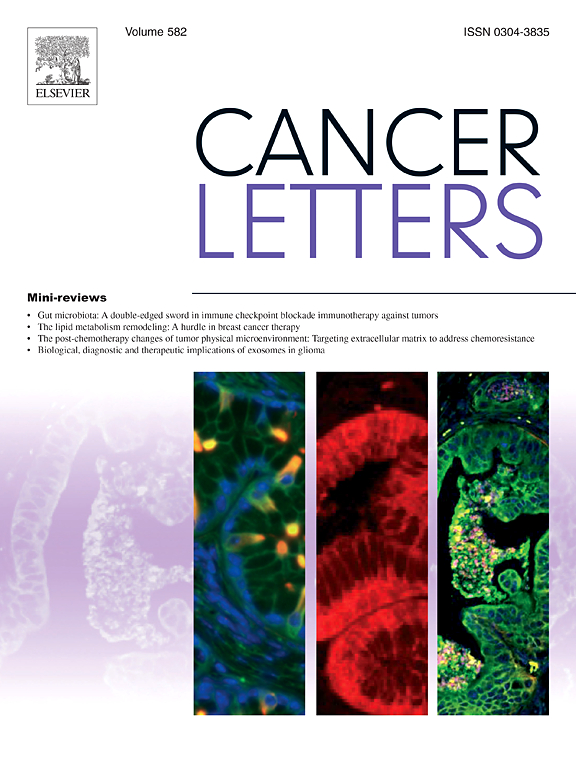去糖基化PD-L1是免疫检查点阻断反应的生物标志物:台湾乳腺癌患者的真实世界研究。
IF 9.1
1区 医学
Q1 ONCOLOGY
引用次数: 0
摘要
三阴性乳腺癌(TNBC)的特点是治疗选择有限,预后一般较差。免疫检查点阻断(ICB)疗法,特别是针对PD-1/PD-L1轴的疗法,提供了有希望的治疗途径,但其有效性取决于PD-L1表达的准确评估。在本研究中,我们从台湾多家医院收集154份存档的ICB-naïve TNBC肿瘤样本。我们使用28-8单克隆抗体免疫组化(IHC)染色来比较PD-L1在去糖基化和未去糖基化处理的样品中的检测情况。我们的研究结果显示,在没有去糖基化的标准IHC方案下,33.12%的TNBC样本被归类为PD-L1阴性,这将排除这些患者的ICB治疗资格。去糖基化后,84.31%最初PD-L1阴性的病例被重新分类为PD-L1阳性,表明糖基化导致TNBC样本中27.92%的假阴性率。值得注意的是,去糖基化后较高的PD-L1水平与ICB治疗的有利反应显着相关,特别是在接受派姆单抗和阿特唑单抗的患者中。受试者工作特征(ROC)分析显示,去糖基化的PD-L1与治疗反应之间存在更强的相关性,曲线下面积(AUC)为0.860,而未去糖基化的PD-L1为0.648。这些结果强调了去糖基化在提高PD-L1检测准确性方面的临床重要性,使患者能够更精确地选择ICB治疗方法。将去糖基化纳入PD-L1评估方案可以改善TNBC患者的治疗结果,并将去糖基化的PD-L1作为ICB治疗反应的更可靠的生物标志物。本文章由计算机程序翻译,如有差异,请以英文原文为准。
Deglycosylated PD-L1 is a biomarker for immune checkpoint blockade response: a real-world study in breast cancer patients in Taiwan
Triple-negative breast cancer (TNBC) is characterized by limited therapeutic options and a generally poor prognosis. Immune checkpoint blockade (ICB) therapies, particularly those targeting the PD-1/PD-L1 axis, offer promising treatment avenues, yet their effectiveness is contingent upon accurate assessment of PD-L1 expression. In this study, we collected 154 archived ICB-naïve TNBC tumor samples from multiple hospitals across Taiwan. We used immunohistochemistry (IHC) staining with the 28-8 monoclonal antibody to compare PD-L1 detection in samples treated with and without deglycosylation. Our findings revealed that under the standard IHC protocol without deglycosylation, 33.12 % of TNBC samples were classified as PD-L1 negative, which would have excluded these patients from ICB therapy eligibility. After deglycosylation, 84.31 % of the initially PD-L1-negative cases were reclassified as PD-L1 positive, indicating that glycosylation led to a 27.92 % false-negative rate in the TNBC samples. Notably, higher PD-L1 levels post-de-glycosylation were significantly associated with favorable responses to ICB treatments, particularly among patients receiving pembrolizumab and atezolizumab. Receiver operating characteristic (ROC) analysis demonstrated a stronger correlation between deglycosylated PD-L1 and treatment response, with an area under the curve (AUC) of 0.860, compared to 0.648 for non-deglycosylated PD-L1. These results underscore the clinical importance of deglycosylation in enhancing PD-L1 detection accuracy, enabling more precise patient selection for ICB therapies. Incorporating deglycosylation into PD-L1 assessment protocols may improve treatment outcomes for TNBC patients and establish deglycosylated PD-L1 as a more reliable biomarker for ICB therapy response.
求助全文
通过发布文献求助,成功后即可免费获取论文全文。
去求助
来源期刊

Cancer letters
医学-肿瘤学
CiteScore
17.70
自引率
2.10%
发文量
427
审稿时长
15 days
期刊介绍:
Cancer Letters is a reputable international journal that serves as a platform for significant and original contributions in cancer research. The journal welcomes both full-length articles and Mini Reviews in the wide-ranging field of basic and translational oncology. Furthermore, it frequently presents Special Issues that shed light on current and topical areas in cancer research.
Cancer Letters is highly interested in various fundamental aspects that can cater to a diverse readership. These areas include the molecular genetics and cell biology of cancer, radiation biology, molecular pathology, hormones and cancer, viral oncology, metastasis, and chemoprevention. The journal actively focuses on experimental therapeutics, particularly the advancement of targeted therapies for personalized cancer medicine, such as metronomic chemotherapy.
By publishing groundbreaking research and promoting advancements in cancer treatments, Cancer Letters aims to actively contribute to the fight against cancer and the improvement of patient outcomes.
 求助内容:
求助内容: 应助结果提醒方式:
应助结果提醒方式:


